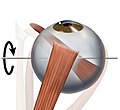Inferior oblique muscle
| Inferior oblique | |
|---|---|
abduction | |
| Identifiers | |
| Latin | musculus obliquus inferior bulbi |
| TA98 | A15.2.07.019 |
| TA2 | 2051 |
| FMA | 49040 |
| Anatomical terms of muscle] | |
The inferior oblique muscle or obliquus oculi inferior is a thin, narrow muscle placed near the anterior margin of the floor of the
Structure
The inferior oblique arises from the orbital surface of the
Passing lateralward, backward, and upward, between the
In humans, the muscle is about 35 mm long.[1]
Innervation
The inferior oblique is innervated by the inferior division of the oculomotor nerve (cranial nerve III).
Function
Its
Primary action is
The inferior oblique muscle is the only muscle that is capable of elevating the eye when it is in a fully adducted position.[2]

Clinical significance
While commonly affected by palsies of the inferior division of the oculomotor nerve, isolated palsies of the inferior oblique (without affecting other functions of the oculomotor nerve) are quite rare.
"Overaction" of the inferior oblique muscle is a commonly observed component of childhood strabismus, particularly infantile esotropia and exotropia. Because true hyperinnervation is not usually present, this phenomenon is better termed "elevation in adduction".[3]
Surgical procedures of the inferior oblique include: loosening (also known as recession see Strabismus surgery), myectomy, marginal myotomy, and denervation and extirpation. It is also encountered and identified in lower lid blepharoplasty surgeries.
Additional images
-
Eye movement of lateral rectus muscle, superior view
-
Eye movement of medial rectus muscle, superior view
-
Eye movement of inferior rectus muscle, superior view
-
Eye movement of superior rectus muscle, superior view
-
Eye movement of superior oblique muscle, superior view
-
Eye movement of inferior oblique muscle, superior view
-
Anterior view
-
Dissection showing origins of right ocular muscles, and nerves entering by the superior orbital fissure.
-
Inferior oblique muscle
-
Extrinsic eye muscle. Nerves of orbita. Deep dissection.
-
Extrinsic eye muscle. Nerves of orbita. Deep dissection.
References
![]() This article incorporates text in the public domain from page 1023 of the 20th edition of Gray's Anatomy (1918)
This article incorporates text in the public domain from page 1023 of the 20th edition of Gray's Anatomy (1918)
- ISBN 978-0071634205.
- ^ "Eye Theory". Cim.ucdavis.edu. Archived from the original on 2014-05-27. Retrieved 2012-12-07.
- PMID 16682590.
External links
- Anatomy figure: 29:01-08 at Human Anatomy Online, SUNY Downstate Medical Center
- lesson3 at The Anatomy Lesson by Wesley Norman (Georgetown University) (orbit5)
- Image at childrenshospital.org











